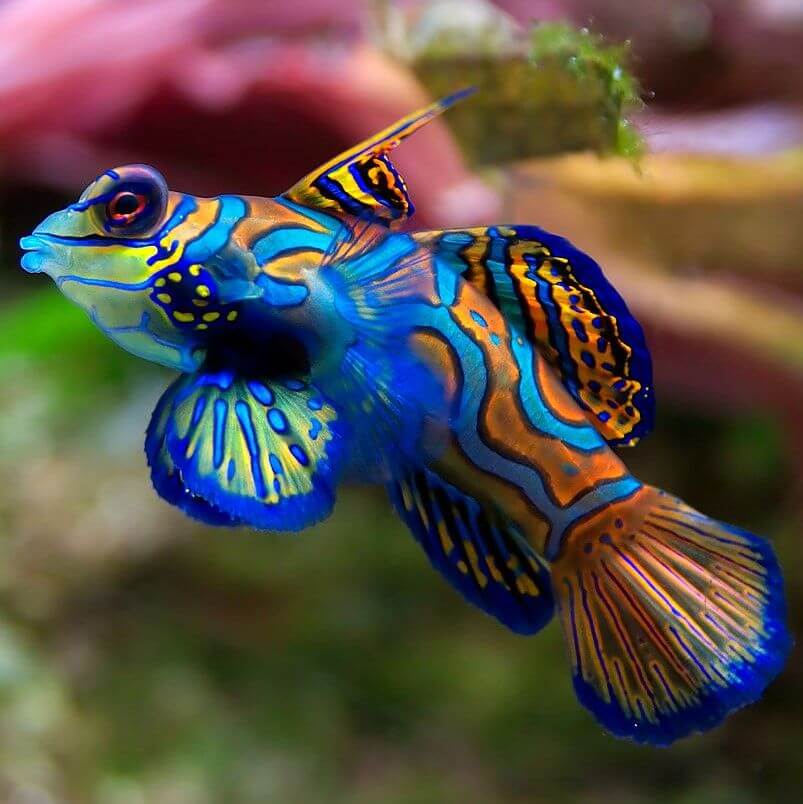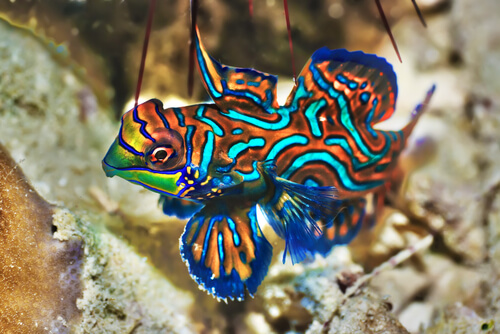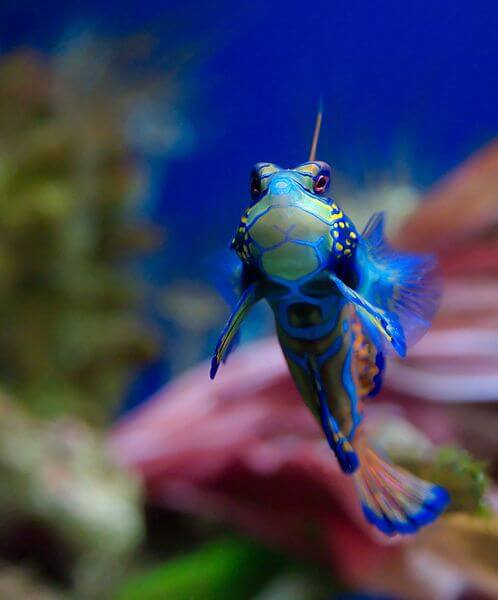5 Curiosities About the Mandarinfish

The mandarinfish or mandarin dragonet owes its name to the intense and varied coloration of its body, which resembles the tunics worn by the Chinese emperors in ancient times. Its scientific name is Synchiropus splendidus and it can be found among the corals of the salty waters of the Indian and Pacific oceans.
It’s a relatively small animal, reaching only 8 centimeters (just over 3 inches) in length in its adult stage. It has a rounded head and an elongated body, with large eyes that give it greater visibility among the rocky areas of the corals. It also has a protractile mouth, which is armed with several rows of very fine teeth. It also has two pectoral fins, two pelvic fins, two dorsal fins, an anal fin and a caudal fin.
Mandarinfish diet
The mandarinfish is omnivorous, although it prefers to feed on other living animals such as small fry, crustaceans, marine worms, among others. Thanks to its visual capacity, it’s able to catch its prey in the dark areas created by the rocks of the sea.
Habitat and reproduction of the mandarinfish
This fish inhabits the warm and tropical water bottoms of the Indian and Pacific oceans, at depths of 1 to 18 meters (3 to 60 feet) and temperatures between 24 to 26 degrees Celsius (75 to 79 Fahrenheit). It has a preference for coral reefs in areas of the western Pacific, Malaysia, Indonesia, the Philippines and Australia. Reproduction occurs several times throughout the year, giving birth to between 200 and 300 fish each time.
The fertilized eggs “swim” in the current for 20 hours, during which time they begin to hatch larvae of approximately 1 millimeter. Once hatched, they begin to feed on plankton. After two weeks, they move on to the reef in search of prey.
Now that you know the main characteristics of the mandarinfish, here are the reasons why this animal is considered one of the most curious and particular of its species.

Mandarinfish curiosities
1. Coloring
These fantastic fish are one of only two known species that have blue coloration in their cellular pigment. Their head is a sky blue background mixed with yellow and orange. The body is mainly orange with intense blue stripes.
At the tip of its back, the orange is darker with blue and green stripes. Its dorsal fins are of similar coloration to its body, however, their edges stand out for the bright blue color they display. Finally, its eyes are orange and its mouth is light blue.
Its coloration is mainly used for two things. One is to camouflage itself among the corals and go unnoticed, and the other is to warn predators of its danger.
2. Mating
The courtship begins at dusk, when several females approach the place where the males are in a circular parade. Once the female chooses her mate, she lies down on the male’s pelvic fin. Subsequently, both stick their bellies together and swim at a height of 1 meter (3.3 feet) above the reef.
At the final moment, the male releases the sperm and the female does the same, releasing a mass of up to 300 eggs. Once the encounter is over, both disperse and swim off to their own side.
Generally, females prefer larger males within the reef. However, the curious thing about this species is that the smaller males have developed a strategy to reproduce and thus preserve their lineage. When the female releases her eggs, the smaller fish release their sperm in the hope of fertilizing some of them.
3. Behavior
The mandarin fish is a very quiet animal, one could even say that, in human terms, it’s “shy”. During the day it’s very difficult to observe them, as they’re generally nocturnal animals; at night is when they come out of their hiding places to mate or hunt.
On the other hand, although they don’t have any problems with other kinds of fish in the reef, if you put two mandarin fish inside an aquarium, they will fight to the death because they are very territorial with their own kind.
4. Defense
This kind of fish belongs to the group of scaleless fish. However, to compensate for this lack of defense, mandarinfish produce a slimy substance that coats their entire body. This coating has a very unpleasant odor and is toxic to predators. In addition, this fatty film also protects it from various skin diseases.

5. Life and feeding in aquariums
To ensure the well-being of mandarinfish in aquariums, they should be sufficiently spacious with a capacity of 150 to 200 liters (32 to 44 gallons). Likewise, it should be ensured that the water is as in its natural environment, i.e. at 24 to 26 degrees Celsius (79 to 82 Fahrenheit).
On the other hand, the aquarium should have low lighting and places where it can hide. Likewise, it should be noted that two males of this species should not be included in the same aquarium due to their territoriality.
One of the most important aspects to take into account when keeping a mandarin fish in an aquarium is its feeding. In the wild, this fish feeds mainly on live animals. In artificial environments, this type of prey isn’t usually available, so feeding can be a problem.
For this reason, aquariums should have a mature ecosystem, where the fish can find benthic fauna and worms to feed on. It’s also recommended that you breed artemia, small crustaceans that should be introduced alive into the aquarium to be eaten by the fish.
On the other hand, according to a study published in the International Journal of Molecular Sciences, mandarinfish can be trained to learn and adapt to eating dead prey and flake food. However, some may reject this type of food; they’ll refuse to eat and end up dying.
In aquariums, this fish can live up to 6 years, compared to the 15 years it can live in its natural environment.
All cited sources were thoroughly reviewed by our team to ensure their quality, reliability, currency, and validity. The bibliography of this article was considered reliable and of academic or scientific accuracy.
- He S, Li L, Lv LY, Cai WJ, Dou YQ, Li J, et al. Mandarin fish (Sinipercidae) genomes provide insights into innate predatory feeding. Communications biology. 2020;3(1):361.
- Li W, Hicks BJ, Lin M, Guo C, Zhang T, Liu J, et al. Impacts of hatchery-reared mandarin fish Siniperca chuatsi stocking on wild fish community and water quality in a shallow Yangtze lake. Scientific reports. 2018;8(1):11481.
- Ohno Y, Otaki JM. Eyespot colour pattern determination by serial induction in fish: Mechanistic convergence with butterfly eyespots. Scientific reports. 2012;2:290.
- Peng J, Dou YQ, Liang H, He S, Liang XF, Shi LJ. Social Learning of Acquiring Novel Feeding Habit in Mandarin Fish (Siniperca chuatsi). International journal of molecular sciences. 2019;20(18).
